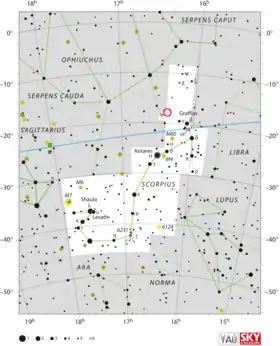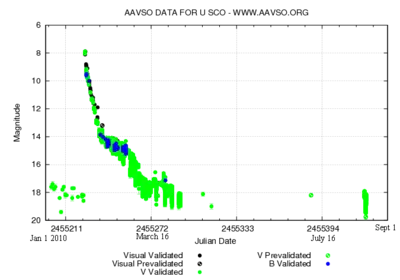U Scorpii
U Scorpii (U Sco) is a recurrent nova system; one of 10 known recurring novae in the Milky Way galaxy.[4] Located near the northern edge of the constellation Scorpius it normally has a magnitude of 18, but reaches a magnitude of about 8 during outbursts. Outbursts have been observed in 1863, 1906, 1936, 1979, 1987, 1999, and 2010.[5][6]
 | |
| Observation data Epoch J2000 Equinox J2000 | |
|---|---|
| Constellation | Scorpius |
| Right ascension | 16h 22m 30.78s[1] |
| Declination | −17° 52′ 42.8″[1] |
| Apparent magnitude (V) | 7.5 Max. 17.6 Min.[2] |
| Characteristics | |
| Spectral type | ? / White Dwarf |
| Variable type | Recurrent nova[2] |
| Astrometry | |
| Radial velocity (Rv) | 65[3] km/s |
| Proper motion (μ) | RA: 0.519±0.397[1] mas/yr Dec.: −7.869±0.297[1] mas/yr |
| Parallax (π) | −0.3521 ± 0.2148[1] mas |
| Distance | 19600+21000 −5300[2] pc |
| Other designations | |
| Database references | |
| SIMBAD | data |
The most recent outburst, on 28 Jan 2010, was predicted to occur April 2009 ± 1.0 year, based on observations during quiescence following the 1999 outburst.[7] The U Sco 2010 eruption faded by 1 magnitude in 1 day, and by 4 magnitudes in 6 days. By February 6 it was dimmer than magnitude 13. Between February 10–19, it was flickering around magnitude 14. The eruption ended on day 64, which is the fastest observed decline to quiescence of recurring nova. This eruption of U Sco is now the best-observed nova event with 22,000 magnitudes already accumulated. Astronomers have predicted that another eruption of U Sco will occur in 2020±2.[8]

References
- Brown, A. G. A.; et al. (Gaia collaboration) (August 2018). "Gaia Data Release 2: Summary of the contents and survey properties". Astronomy & Astrophysics. 616. A1. arXiv:1804.09365. Bibcode:2018A&A...616A...1G. doi:10.1051/0004-6361/201833051. Gaia DR2 record for this source at VizieR.
- Schaefer, Bradley E. (2018). "The distances to Novae as seen by Gaia". Monthly Notices of the Royal Astronomical Society. 481 (3): 3033–3051. arXiv:1809.00180. Bibcode:2018MNRAS.481.3033S. doi:10.1093/mnras/sty2388. S2CID 118925493.
- "U Scorpii". SIMBAD. Centre de données astronomiques de Strasbourg. Retrieved 2019-08-17.
- Comprehensive Photometric Histories of All Known Galactic Recurrent Novae, B. Schaefer
- The 1999 Outburst of the Recurrent Nova U Scorpii, Anupama & Dewangan
- Thar She Blows! U Scorpii Erupts as Predicted, A. MacRobert
- B. Schaefer; A. Pagnotta; et al. (October 2010). "Discovery of the 2010 Eruption and the Pre-Eruption Light Curve for Recurrent Nova U Scorpii". The Astronomical Journal. 140 (4): 925–932. arXiv:1004.2842. Bibcode:2010AJ....140..925S. doi:10.1088/0004-6256/140/4/925. S2CID 118394042. Retrieved 12 February 2015.
- Matthew Templeton (May 6, 2010). "Long-term monitoring of the recurrent nova U Scorpii". AAVSO. Retrieved 2010-11-15.
External links
- http://www.phys.lsu.edu/dept/people/schaefer.html
- U Scorpii in Outburst
- Long-term monitoring of the recurrent nova U Scorpii (AAVSO 2010 April 9)
- AAVSO: Quick Look View of AAVSO Observations (get recent magnitude estimates for U Sco)